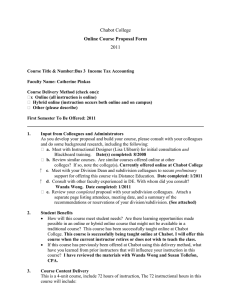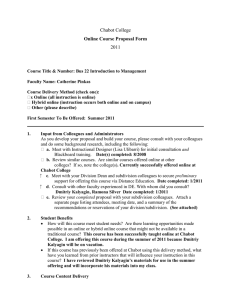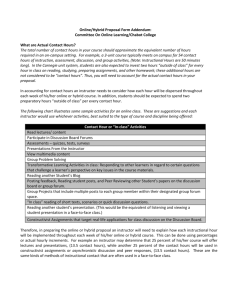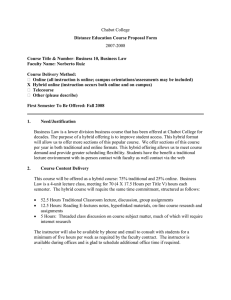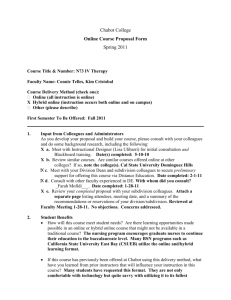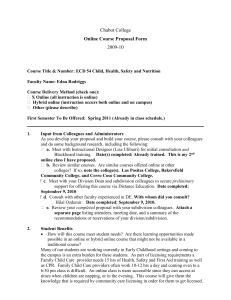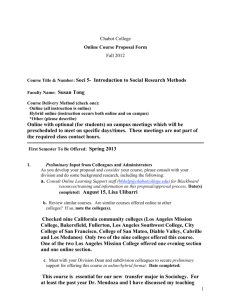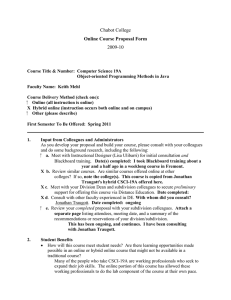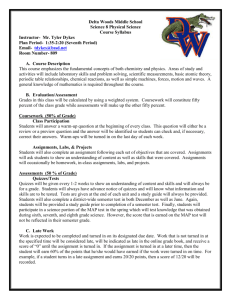Bus 93 - Chabot College
advertisement
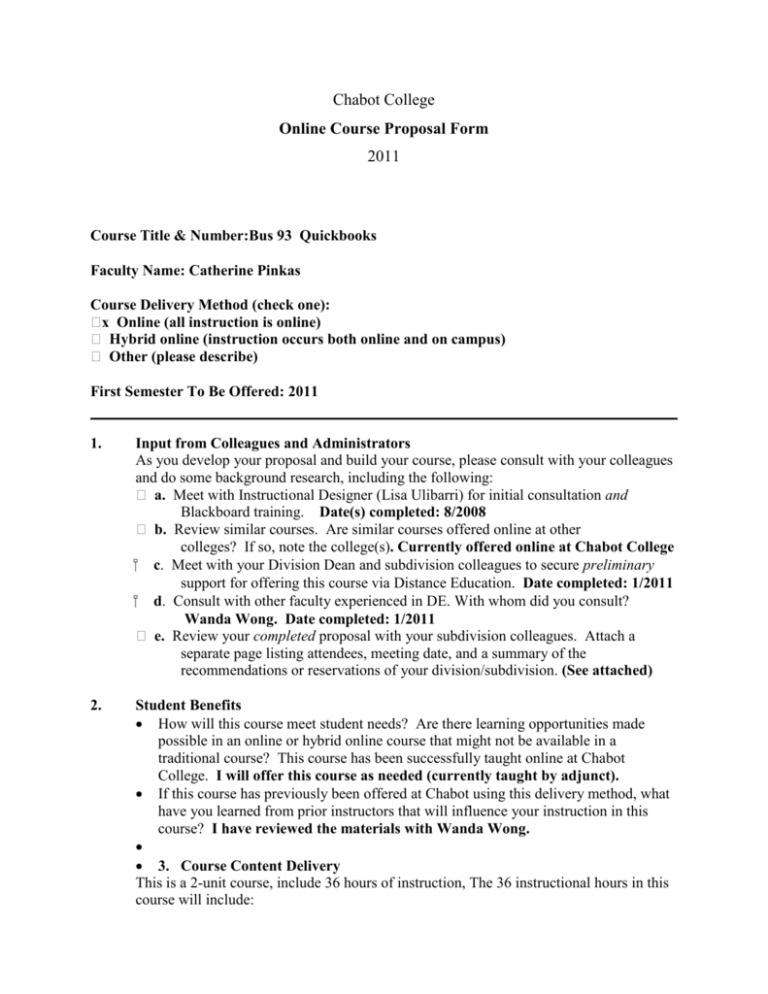
Chabot College Online Course Proposal Form 2011 Course Title & Number:Bus 93 Quickbooks Faculty Name: Catherine Pinkas Course Delivery Method (check one): x Online (all instruction is online) Hybrid online (instruction occurs both online and on campus) Other (please describe) First Semester To Be Offered: 2011 1. Input from Colleagues and Administrators As you develop your proposal and build your course, please consult with your colleagues and do some background research, including the following: a. Meet with Instructional Designer (Lisa Ulibarri) for initial consultation and Blackboard training. Date(s) completed: 8/2008 b. Review similar courses. Are similar courses offered online at other colleges? If so, note the college(s). Currently offered online at Chabot College c. Meet with your Division Dean and subdivision colleagues to secure preliminary support for offering this course via Distance Education. Date completed: 1/2011 d. Consult with other faculty experienced in DE. With whom did you consult? Wanda Wong. Date completed: 1/2011 e. Review your completed proposal with your subdivision colleagues. Attach a separate page listing attendees, meeting date, and a summary of the recommendations or reservations of your division/subdivision. (See attached) 2. Student Benefits How will this course meet student needs? Are there learning opportunities made possible in an online or hybrid online course that might not be available in a traditional course? This course has been successfully taught online at Chabot College. I will offer this course as needed (currently taught by adjunct). If this course has previously been offered at Chabot using this delivery method, what have you learned from prior instructors that will influence your instruction in this course? I have reviewed the materials with Wanda Wong. 3. Course Content Delivery This is a 2-unit course, include 36 hours of instruction, The 36 instructional hours in this course will include: 6 hours of threaded discussion for students to discuss Quickbook topics as determined by the instructor. Includes student to teacher and student to student interactions 8 hours of Quick books team project including student to student and student to teacher interaction 8 hours to complete exams and quizzes on course materials to assess application of course content 12 hours of problem review and discussion to assure comprehension of course material 2 hours of instructor lectures on supplemental course materials 4 5. What percentage of the course will be on-campus, if any? What percentage of the course will consist of online lecture, video, podcasts, email, supplemental websites, CD-ROM, etc.? All course materials will be available online lecture, email, supplemental websites. Will any portion of your course be synchronous, requiring students to be online at the same time? If so, describe those activities, and how you will provide flexibility for students who may be unable to participate at any given time. Course is asynchronous Nature and Frequency of Instructor-Student Interactions I will monitor, guide and participate in discussion forms. I will send email/announcements to provide additional information, instruction or guidance as determined by the needs seen in the overall course participation. I will provide individual and group feedback on all course assignments. I will be available by email to answer questions on an individual basis. Nature and Frequency of Student-Student Interactions Students will interact with each other actively during the week on the discussion forum. Their input will be graded. Students will also be required to view the projects of their colleagues, and to provide at least 2 follow-up questions. Students will be able to interact to discuss problem sets and provide feedback to each other before the assignments are graded. 6. Assessment of Student Learning The major assessments in this class will include: Discussion board participation: 10% of grade Quick Books Project: 30% of grade Problems: 30% of grade Quizzes and Exams: 30% of grade 7. Technology No special requirements 8. Accommodations for Students with Disabilities 9. I don’t anticipate any video or audio materials but if I use them I will close caption them. Submit your proposal (electronic version via email and hard copy via campus mail) to the chair of the Committee on Online Learning. Faculty signature: _______________________________ Date: _______________ Division Dean signature: __________________________ Date: ________________ Online/Hybrid Proposal Form Addendum: Committee On Online Learning/Chabot College What are Actual Contact Hours? The total number of contact hours in your course should approximate the equivalent number of hours required in an on-campus setting. For example, a 3-unit course typically meets on campus for 54 contact hours of instruction, assessment, discussion, and group activities, (Note: Instructional Hours are 50 minutes long). In the Carnegie unit system, students are also expected to invest two hours “outside of class” for every hour in class on reading, studying, preparing assignments, and other homework; these additional hours are not considered to be “contact hours”. Thus, you will need to account for the actual contact hours in your proposal. In accounting for contact hours an instructor needs to consider how each hour will be dispersed throughout each week of his/her online or hybrid course. In addition, students should be expected to spend two preparatory hours “outside of class” per every contact hour. The following chart illustrates some sample activities for an online class. These are suggestions and each instructor would use whichever activities, best suited to the type of course and discipline being offered: Contact Hour or “In-class” Activities Read lectures/ content Participate in Discussion Board Forums Assessments – quizzes, tests, surveys Presentations From the Instructor View multimedia content Group Problem Solving Transformative Learning Activities in class: Responding to other learners in regard to certain questions that challenge a learner’s perspective on key issues in the course materials. Reading another Student’s Blog Posting feedback, Reading student posts, and Peer Reviewing other Student’s papers on the discussion board or group forum. Group Projects that include multiple posts to each group member within their designated group forum space. “In class” reading of short texts, scenarios or quick discussion questions. Reading another student’s presentation. (This would be the equivalent of listening and viewing a student presentation in a face-to-face class.) Constructivist Assignments that target real-life applications for class discussion on the Discussion Board. Therefore, in preparing the online or hybrid proposal an instructor will need to explain how each instructional hour will be implemented throughout each week of his/her online or hybrid course. This can be done using percentages or actual hourly increments. For example an instructor may determine that 25 percent of his/her course will offer lectures and presentations, (13.5 contact hours), while another 25 percent of the contact hours will be used in constructivist assignments or asynchronistic discussion and peer responses, (13.5 contact hours). These are the same kinds of methods of instructional contact that are often used in a face-to-face class. bb However, there are certain learning activities that may not meet the criteria of actual “contact hours”. This chart reflects instructional, preparatory “outside of class” activities that in some cases would not necessarily be considered actual contact hours. Preparatory or “Outside of Class” Activities Read Textbooks Research Preparing assignments Viewing an internet site for one’s own research purposes. Individual Reflective Writing Journaling Writing /Composing a Blog Analyzing another student’s ideas individually. Using a WIKI for posting ideas to other class members in preparation for a Group Project. Outside reading of additional texts pertaining to the course subject matter as homework preparation. Preparing an individual class presentation. Reviewing class notes. In summary, “contact hours” are usually those segments of instructional time where the student is actively engaged in learning activities and would reflect the same type of instruction implemented in a traditional face-to-face classroom. Therefore, instructors are encouraged to offer a clear breakdown of “contact hours” in the section of the proposal entitled, “Course Content Delivery”.
